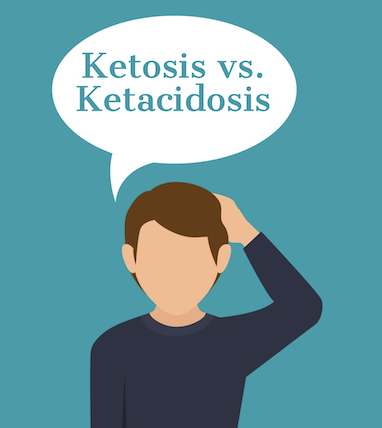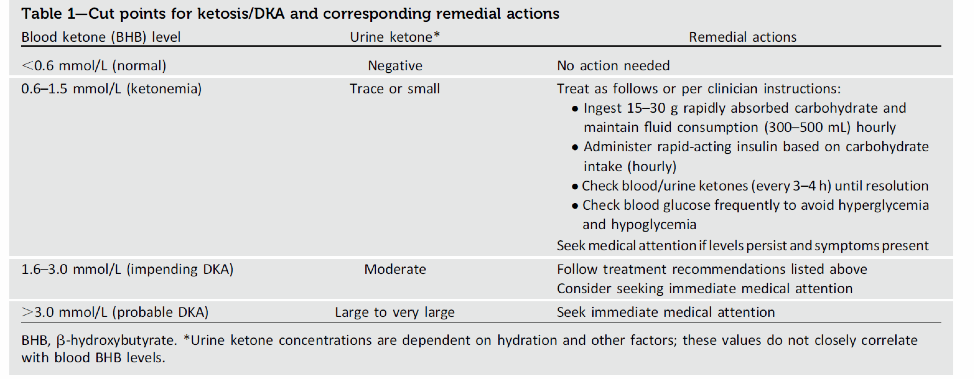Ketosis vs. Ketoacidosis: What’s the Difference?
By Kara Miecznikowski
 While ketosis and ketoacidosis sound quite similar – and both describe elevated ketones in the blood – there are critical differences
While ketosis and ketoacidosis sound quite similar – and both describe elevated ketones in the blood – there are critical differences
Ketosis may be a normal, safe body response to low-carbohydrate diets or not eating for a certain period of time (fasting). On the other hand, ketoacidosis can be a dangerous and life-threatening complication where too many ketones will make your blood acidic.
What are Ketones?
Ketones are produced from fat and can be used as an alternative source of energy for the body when its cells are low on glucose (sugar) for a period of time. This is generally a result of very low levels of insulin (the “key” needed for sugar to enter most cells). In response, the body releases fat stored in fat cells. The fat then travels to the liver, where it is broken down into ketones, which are used as one source of alternative energy instead of glucose.
What is Ketosis?
Ketosis is when ketones accumulate in your blood. It may be a normal process that occurs when your body doesn’t have enough carbohydrates, so it breaks down fat into ketones for energy. The term “ketosis” refers to the presence of ketones in the blood. This is usually not problematic. Ketosis can occur when a person is fasting or following a very low-carbohydrate diet, sometimes called a ketogenic diet. It’s common to be in a low-level state of ketosis when waking up in the morning, as the body was “fasting” during the night.
Low-carbohydrate diets may be used to purposely achieve ketosis – reducing carbohydrates to fewer than 50 grams per day has been shown to result in weight loss and A1C reduction. This is one component of Virta Health’s remote medical care platform to put type 2 diabetes into remission.
If you have type 1 diabetes, there is no way to know if ketosis is caused just by fasting or by an insufficient amount of insulin. It is safest to assume any ketosis greater than 0.5 mmol/L is too much if you have type 1 diabetes. Try to keep ketone levels undetectable or at least less than 0.5 mmol/L.
What is Ketoacidosis?
Ketoacidosis, or diabetic ketoacidosis (DKA) in people with diabetes, is a complication of diabetes that occurs when a person does not have enough insulin. The body responds by breaking down fat into ketones too rapidly, resulting in high levels of ketones in the blood (far more than the normal amount in people without type 1 diabetes).
Ketones are acidic molecules, so an increased level of ketones can cause the blood to become more acidic which prevents the body’s processes from working normally. By definition, ketone levels in DKA are too high, causing the blood to become dangerously acidic. If left unaddressed, even for a few hours, this impairs the function of the brain and other organs and can be life threatening.
How Can I Tell the Difference Between Ketosis and Ketoacidosis?
Ketosis and ketoacidosis differ between how elevated the ketone level is in the blood. You can measure your ketone levels in your blood with a meter.
Blood ketone meter measurements (BHB) with a meter:
 From Danne T, et al. Diabetes Care. 2019 Jun;42(6):1147-1154.
From Danne T, et al. Diabetes Care. 2019 Jun;42(6):1147-1154.
Blood ketone meters available in the US include:
- Precision Xtra: Meter costs $27.50, strips cost anywhere from $1.00 to $5.00 each, depending on the store
- NovaMax Plus: Meter costs $26 on Amazon, strips cost anywhere from $1.50 to $2.50 each
- Keto-Mojo: $60 for bundled meter, lancets, and 10 strips
Insurance coverage of ketone meters varies widely; call your insurer and ask if/which ketone meters are covered.
Urine ketone strips are less expensive, but not as accurate as blood ketone meters, since the urine test results are indicative of blood ketone levels in the past. Accuracy of urine strips is also affected by hydration levels and kidney function.
Who is at Risk for DKA?
DKA is most commonly experienced by people with type 1 diabetes because people with type 2 generally have some insulin production. People with type 2 diabetes can also develop DKA, but with a much lower risk – although when it develops, complications can be just as severe. Type 1 patients taking SGLT-2 inhibitors are at higher risk of ketoacidosis; though, it’s widely believed that DKA caused by SGLT-2 inhibitors may be able to be prevented if the proper steps are taken quickly. See our infographic here! For more background on SGLT inhibitors for type 1 diabetes, see here.
Symptoms of DKA
The symptoms of DKA should be taken very seriously because of how quickly ketoacidosis can progress. Early symptoms of high blood sugar which may precede the development of DKA include:
- Thirst and dehydration
- Dry mouth
- Frequent urination
If left untreated, more severe symptoms may occur quite rapidly, including:
- Nausea
- Vomiting
- Severe abdominal pain
- Breathing trouble
- Confusion and extreme fatigue
Identifying symptoms early on can be critical for a person’s health and safety. See our infographic on strategies to reduce risk for DKA here.








